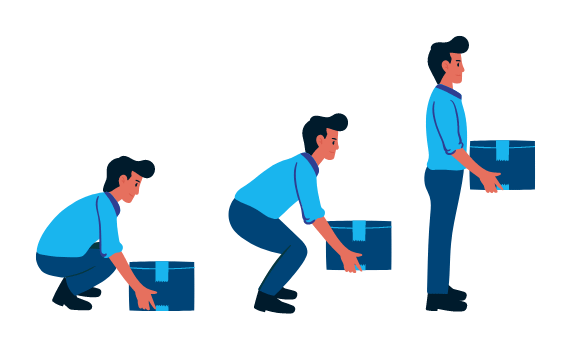
Exercises
Alleviating Back Pain
If you’ve been struggling with pain for a while, it’s possible that inactivity
has caused weakness in the muscles of your trunk and spine.
To alleviate back pain, it’s important to maintain proper posture when lifting and carrying,
while also strengthening the core muscles around your trunk. We’ve outlined some easy
guidelines for maintaining good form while lifting and carrying, along with simple exercises
you can do anytime, anywhere.
By incorporating these practices into your daily routine, you’ll greatly improve your
ability to manage pain and enjoy life to the fullest, despite any discomfort you may
experience.
Body Posture When Lifting & Carrying
We all need to lift and carry things as part of our daily
routines: boxes, children, pets, golf clubs, etc. The problem is, we often lift incorrectly:
using our backs as a crane, or twisting while we are lifting. We also often use poor posture
while walking with an object, or poor technique in putting down an object.
The Golden Rule of Lifting: Maintain a “neutral spine”. Maintaining a “neutral spine” means
keeping your shoulders, hips, and knees in alignment with one another. (i.e. no bending
forward or backward, and no twisting). It is also important to keep objects as close to the
body as possible during the lifting and carrying of objects. There are four basic lifts: The
Squat, The Genuflect, The Straight Back Bend, and the Golfer’s Lift.
The Squat

To lift medium objects from the ground, especially when a squat lift doesn’t get you low enough.
Technique
Maintain an upright posture and kneel down onto one knee, pull the object up to your belly, and stand.
The Genuflect (AKA 1/2 Kneeling)

To lift medium objects from the ground, especially when a squat lift doesn’t get you low enough.
Technique
Maintain an upright posture and kneel down onto one knee, pull the object up to your belly, and stand.
The Straight Back Bend

To bend over objects such as a sink to brush your teeth or wash your hands, and for reaching.
Technique
Maintain a neutral spine and pivot forward from the hips (top of legs) not the waist (low back). It often helps to bend the knees slightly.
The Golfer’s Lift

To pick up small and light objects. This is good for getting canned goods out of a shopping cart.
Technique
You must have a stick, cane or other object to lean on in order to perform this lift. Lean one hand on your stick (maintain a neutral spine!), and pivot forward from the hips, while allowing the opposite leg to rise up behind you.
Trunk Stabilization Exercises
By targeting your core muscles, trunk stabilization exercises can help improve balance, reduce back pain, and increase strength. By incorporating exercises like leg lifts and push ups into your routine, you can start to see improvements in everything from your posture to your athletic performance. You don’t need any fancy equipment to get started - just your own bodyweight will do! We’ve also outlined less and more strenuous versions of each exercise.
Leg Lifts

Technique
Lie flat on your back, and place your hands palm down beneath your pelvis/lower back. Lift both legs approx 6 to 12 inches off the floor and hold for a count of two. Then relax. Do in sets of 10 lifts. Try for 4 sets per day.
Less strenuous version
To build up the strength to do the “regular version,” sit at the edge of a desk or low counter/table. Angle your upper body backward (remember to keep your entire body straight!) until your toes are barely on the floor. Now lean back slightly to lift your legs off the floor. Hold for a count of ten.
More strenuous version
Hold your feet approximately 1-2 inches apart as you raise/hold them in the air, and keep them up for a longer period of time.
Military-Style Push-Ups

Technique
Lie flat on your stomach, with your hands palm-down approximately shoulder-width apart, and your elbows flexed, held against your side. Extend your arms, pushing your body up off the floor. Be sure to maintain a neutral spine, so that when you are in the “up” position, your shoulders, hips, and ankles are aligned. Hold in the “up” position for a count of two. Then relax back down to the ground. Do in sets of 10 push-ups. Try for 4 sets per day.
Less strenuous version
To build up the strength to do the “regular version,” start by doing the push-ups against a wall (keeping a neutral spine!). When you can do 4 sets of 10 push-ups against a wall, try doing them on a counter top. Then progress to push-ups on the seat of a chair or a coffee table. Then move to doing them on the floor. Keep at it – you can do it!
More strenuous version
Try doing push-ups on a large exercise ball. Not only do your trunk muscles have to hold you straight, but your other muscles (the obliques, etc) have to hold you from bending left or right!